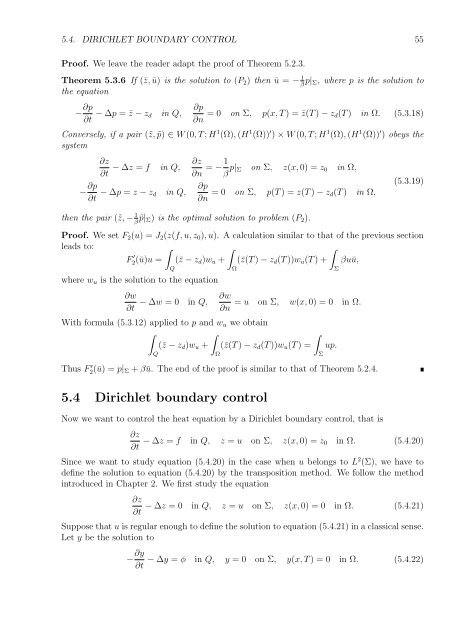Optimal Control of Partial Differential Equations
Optimal Control of Partial Differential Equations
Optimal Control of Partial Differential Equations
Create successful ePaper yourself
Turn your PDF publications into a flip-book with our unique Google optimized e-Paper software.
5.4. DIRICHLET BOUNDARY CONTROL 55<br />
Pro<strong>of</strong>. We leave the reader adapt the pro<strong>of</strong> <strong>of</strong> Theorem 5.2.3.<br />
Theorem 5.3.6 If (¯z, ū) is the solution to (P2) then ū = − 1<br />
β p|Σ, where p is the solution to<br />
the equation<br />
− ∂p<br />
∂t − ∆p = ¯z − zd in Q,<br />
∂p<br />
∂n = 0 on Σ, p(x, T ) = ¯z(T ) − zd(T ) in Ω. (5.3.18)<br />
Conversely, if a pair (˜z, ˜p) ∈ W (0, T ; H 1 (Ω), (H 1 (Ω)) ′ ) × W (0, T ; H 1 (Ω), (H 1 (Ω)) ′ ) obeys the<br />
system<br />
∂z<br />
∂t<br />
− ∆z = f in Q,<br />
− ∂p<br />
∂t − ∆p = z − zd in Q,<br />
∂z 1<br />
= −<br />
∂n β p|Σ on Σ, z(x, 0) = z0 in Ω,<br />
∂p<br />
∂n = 0 on Σ, p(T ) = z(T ) − zd(T ) in Ω,<br />
then the pair (˜z, − 1<br />
β ˜p|Σ) is the optimal solution to problem (P2).<br />
(5.3.19)<br />
Pro<strong>of</strong>. We set F2(u) = J2(z(f, u, z0), u). A calculation similar to that <strong>of</strong> the previous section<br />
leads to:<br />
F ′ <br />
<br />
<br />
2(ū)u = (¯z − zd)wu + (¯z(T ) − zd(T ))wu(T ) + βuū,<br />
where wu is the solution to the equation<br />
∂w<br />
∂t<br />
Q<br />
− ∆w = 0 in Q,<br />
∂w<br />
∂n<br />
Ω<br />
= u on Σ, w(x, 0) = 0 in Ω.<br />
With formula (5.3.12) applied to p and wu we obtain<br />
<br />
<br />
<br />
(¯z − zd)wu + (¯z(T ) − zd(T ))wu(T ) =<br />
Q<br />
Ω<br />
Thus F ′ 2(ū) = p|Σ + βū. The end <strong>of</strong> the pro<strong>of</strong> is similar to that <strong>of</strong> Theorem 5.2.4.<br />
5.4 Dirichlet boundary control<br />
Now we want to control the heat equation by a Dirichlet boundary control, that is<br />
∂z<br />
∂t − ∆z = f in Q, z = u on Σ, z(x, 0) = z0 in Ω. (5.4.20)<br />
Since we want to study equation (5.4.20) in the case when u belongs to L 2 (Σ), we have to<br />
define the solution to equation (5.4.20) by the transposition method. We follow the method<br />
introduced in Chapter 2. We first study the equation<br />
∂z<br />
∂t<br />
− ∆z = 0 in Q, z = u on Σ, z(x, 0) = 0 in Ω. (5.4.21)<br />
Suppose that u is regular enough to define the solution to equation (5.4.21) in a classical sense.<br />
Let y be the solution to<br />
− ∂y<br />
∂t<br />
− ∆y = φ in Q, y = 0 on Σ, y(x, T ) = 0 in Ω. (5.4.22)<br />
Σ<br />
Σ<br />
up.

















